Page 397 of 488
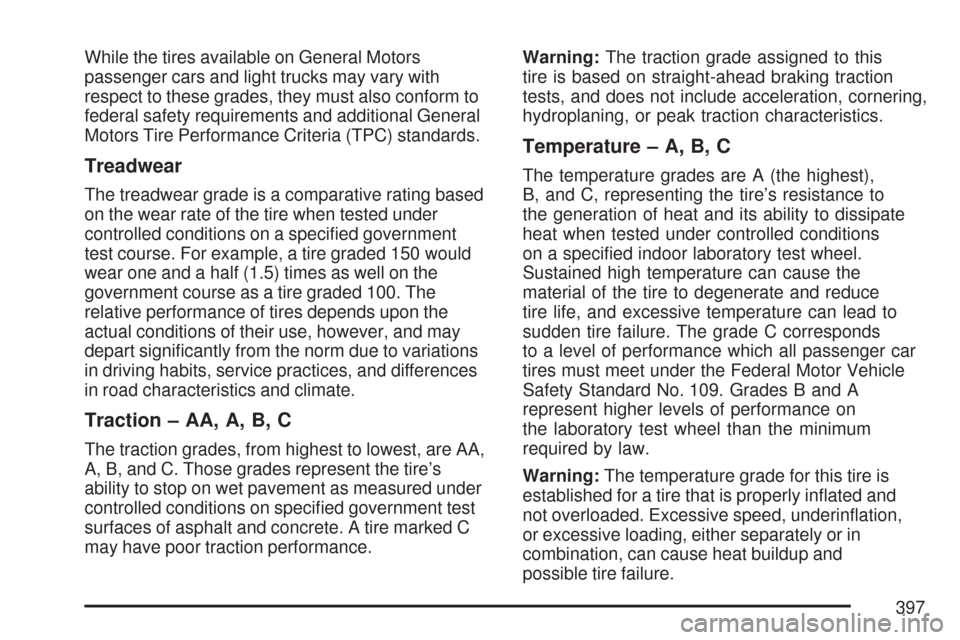
While the tires available on General Motors
passenger cars and light trucks may vary with
respect to these grades, they must also conform to
federal safety requirements and additional General
Motors Tire Performance Criteria (TPC) standards.
Treadwear
The treadwear grade is a comparative rating based
on the wear rate of the tire when tested under
controlled conditions on a speci�ed government
test course. For example, a tire graded 150 would
wear one and a half (1.5) times as well on the
government course as a tire graded 100. The
relative performance of tires depends upon the
actual conditions of their use, however, and may
depart signi�cantly from the norm due to variations
in driving habits, service practices, and differences
in road characteristics and climate.
Traction – AA, A, B, C
The traction grades, from highest to lowest, are AA,
A, B, and C. Those grades represent the tire’s
ability to stop on wet pavement as measured under
controlled conditions on speci�ed government test
surfaces of asphalt and concrete. A tire marked C
may have poor traction performance.Warning:The traction grade assigned to this
tire is based on straight-ahead braking traction
tests, and does not include acceleration, cornering,
hydroplaning, or peak traction characteristics.
Temperature – A, B, C
The temperature grades are A (the highest),
B, and C, representing the tire’s resistance to
the generation of heat and its ability to dissipate
heat when tested under controlled conditions
on a speci�ed indoor laboratory test wheel.
Sustained high temperature can cause the
material of the tire to degenerate and reduce
tire life, and excessive temperature can lead to
sudden tire failure. The grade C corresponds
to a level of performance which all passenger car
tires must meet under the Federal Motor Vehicle
Safety Standard No. 109. Grades B and A
represent higher levels of performance on
the laboratory test wheel than the minimum
required by law.
Warning:The temperature grade for this tire is
established for a tire that is properly in�ated and
not overloaded. Excessive speed, underin�ation,
or excessive loading, either separately or in
combination, can cause heat buildup and
possible tire failure.
397
Page 398 of 488
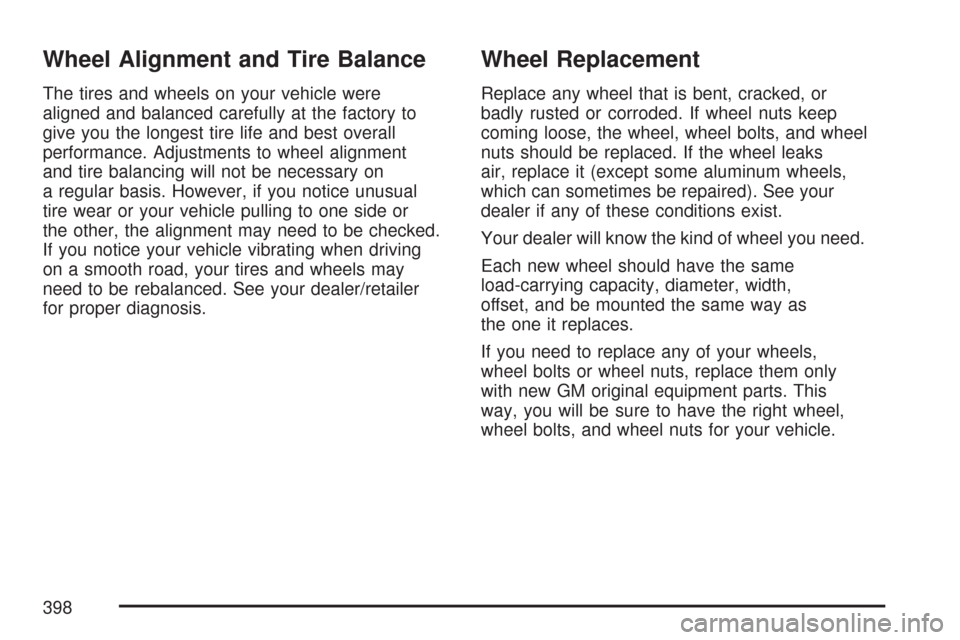
Wheel Alignment and Tire Balance
The tires and wheels on your vehicle were
aligned and balanced carefully at the factory to
give you the longest tire life and best overall
performance. Adjustments to wheel alignment
and tire balancing will not be necessary on
a regular basis. However, if you notice unusual
tire wear or your vehicle pulling to one side or
the other, the alignment may need to be checked.
If you notice your vehicle vibrating when driving
on a smooth road, your tires and wheels may
need to be rebalanced. See your dealer/retailer
for proper diagnosis.
Wheel Replacement
Replace any wheel that is bent, cracked, or
badly rusted or corroded. If wheel nuts keep
coming loose, the wheel, wheel bolts, and wheel
nuts should be replaced. If the wheel leaks
air, replace it (except some aluminum wheels,
which can sometimes be repaired). See your
dealer if any of these conditions exist.
Your dealer will know the kind of wheel you need.
Each new wheel should have the same
load-carrying capacity, diameter, width,
offset, and be mounted the same way as
the one it replaces.
If you need to replace any of your wheels,
wheel bolts or wheel nuts, replace them only
with new GM original equipment parts. This
way, you will be sure to have the right wheel,
wheel bolts, and wheel nuts for your vehicle.
398
Page 399 of 488

{CAUTION:
Using the wrong replacement wheels,
wheel bolts, or wheel nuts on your vehicle
can be dangerous. It could affect the
braking and handling of your vehicle,
make your tires lose air and make you
lose control. You could have a collision
in which you or others could be injured.
Always use the correct wheel, wheel bolts,
and wheel nuts for replacement.
Notice:The wrong wheel can also cause
problems with bearing life, brake cooling,
speedometer or odometer calibration,
headlamp aim, bumper height, vehicle ground
clearance, and tire clearance to the body
and chassis.
{CAUTION:
Rust or dirt on a wheel, or on the parts to
which it is fastened, can make wheel nuts
become loose after a time. The wheel could
come off and cause a crash. When you
change a wheel, remove any rust or dirt
from places where the wheel attaches to
the vehicle. In an emergency, you can use
a cloth or a paper towel to do this; but be
sure to use a scraper or wire brush later,
if you need to, to get all the rust or dirt off.
{CAUTION:
Never use oil or grease on studs or the
threads of the wheel nuts. If you do, the
wheel nuts might come loose and the
wheel could fall off, causing a crash.
399
Page 401 of 488
Tire Chains
{CAUTION:
Do not use tire chains. There is not
enough clearance. Tire chains used on
a vehicle without the proper amount
of clearance can cause damage to the
brakes, suspension, or other vehicle
parts. The area damaged by the tire
chains could cause you to lose control
of your vehicle and you or others
may be injured in a crash.
CAUTION: (Continued)
CAUTION: (Continued)
Use another type of traction device
only if its manufacturer recommends it
for use on your vehicle and tire size
combination and road conditions.
Follow that manufacturer’s instructions.
To help avoid damage to your vehicle,
drive slowly, re-adjust or remove the
device if it is contacting your vehicle,
and do not spin your wheels. If you
do �nd traction devices that will �t,
install them on the rear tires.
401
Page 403 of 488
If you ever use a jack to lift your vehicle, follow
the instructions that came with the jack, and
be sure to use the correct lifting points to avoid
damaging your vehicle.
Notice:Lifting your vehicle improperly
can damage your vehicle and result in
costly repairs not covered by your warranty.
To lift your vehicle properly, follow the
advice in this part.
To help prevent vehicle damage:
Be sure to place a block or pad between
the jack and the vehicle.
Make sure the jack you’re using spans
at least two crossmember ribs.
Lift only in the areas shown in the
following pictures.
For additional information, see your dealer
and the Chevrolet Corvette service manual.
Lifting From the Front
The front lifting points can be accessed from
either side of your vehicle, behind the front tires.
403
Page 406 of 488
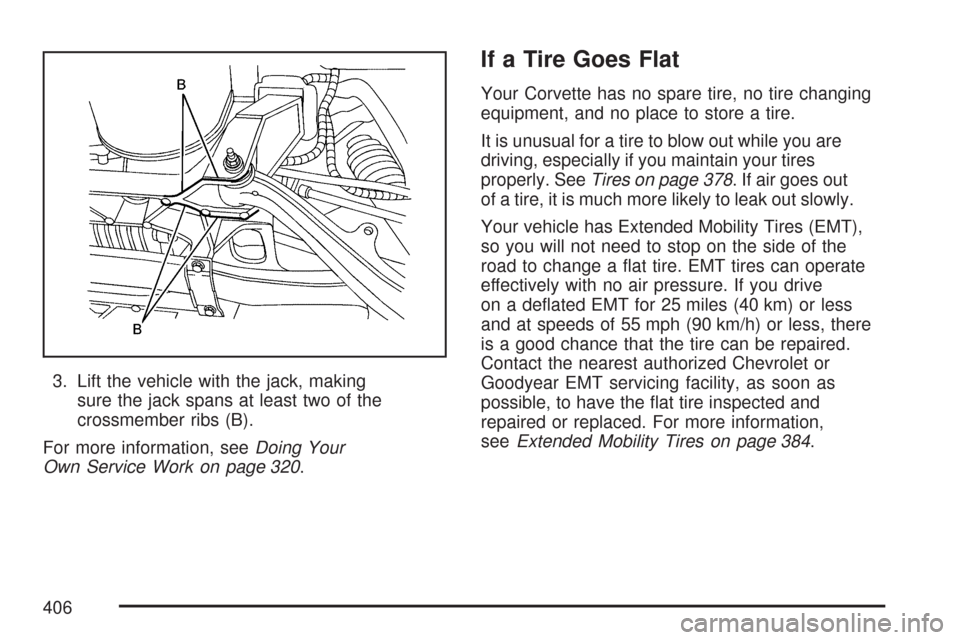
3. Lift the vehicle with the jack, making
sure the jack spans at least two of the
crossmember ribs (B).
For more information, seeDoing Your
Own Service Work on page 320.
If a Tire Goes Flat
Your Corvette has no spare tire, no tire changing
equipment, and no place to store a tire.
It is unusual for a tire to blow out while you are
driving, especially if you maintain your tires
properly. SeeTires on page 378. If air goes out
of a tire, it is much more likely to leak out slowly.
Your vehicle has Extended Mobility Tires (EMT),
so you will not need to stop on the side of the
road to change a �at tire. EMT tires can operate
effectively with no air pressure. If you drive
on a de�ated EMT for 25 miles (40 km) or less
and at speeds of 55 mph (90 km/h) or less, there
is a good chance that the tire can be repaired.
Contact the nearest authorized Chevrolet or
Goodyear EMT servicing facility, as soon as
possible, to have the �at tire inspected and
repaired or replaced. For more information,
seeExtended Mobility Tires on page 384.
406
Page 412 of 488
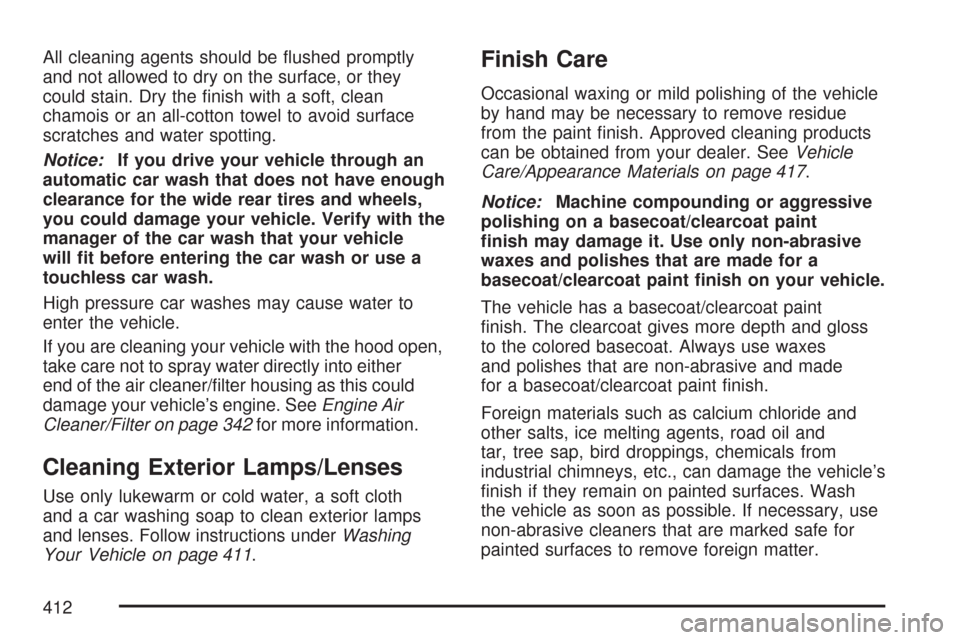
All cleaning agents should be �ushed promptly
and not allowed to dry on the surface, or they
could stain. Dry the �nish with a soft, clean
chamois or an all-cotton towel to avoid surface
scratches and water spotting.
Notice:If you drive your vehicle through an
automatic car wash that does not have enough
clearance for the wide rear tires and wheels,
you could damage your vehicle. Verify with the
manager of the car wash that your vehicle
will �t before entering the car wash or use a
touchless car wash.
High pressure car washes may cause water to
enter the vehicle.
If you are cleaning your vehicle with the hood open,
take care not to spray water directly into either
end of the air cleaner/�lter housing as this could
damage your vehicle’s engine. SeeEngine Air
Cleaner/Filter on page 342for more information.
Cleaning Exterior Lamps/Lenses
Use only lukewarm or cold water, a soft cloth
and a car washing soap to clean exterior lamps
and lenses. Follow instructions underWashing
Your Vehicle on page 411.
Finish Care
Occasional waxing or mild polishing of the vehicle
by hand may be necessary to remove residue
from the paint �nish. Approved cleaning products
can be obtained from your dealer. SeeVehicle
Care/Appearance Materials on page 417.
Notice:Machine compounding or aggressive
polishing on a basecoat/clearcoat paint
�nish may damage it. Use only non-abrasive
waxes and polishes that are made for a
basecoat/clearcoat paint �nish on your vehicle.
The vehicle has a basecoat/clearcoat paint
�nish. The clearcoat gives more depth and gloss
to the colored basecoat. Always use waxes
and polishes that are non-abrasive and made
for a basecoat/clearcoat paint �nish.
Foreign materials such as calcium chloride and
other salts, ice melting agents, road oil and
tar, tree sap, bird droppings, chemicals from
industrial chimneys, etc., can damage the vehicle’s
�nish if they remain on painted surfaces. Wash
the vehicle as soon as possible. If necessary, use
non-abrasive cleaners that are marked safe for
painted surfaces to remove foreign matter.
412
Page 415 of 488
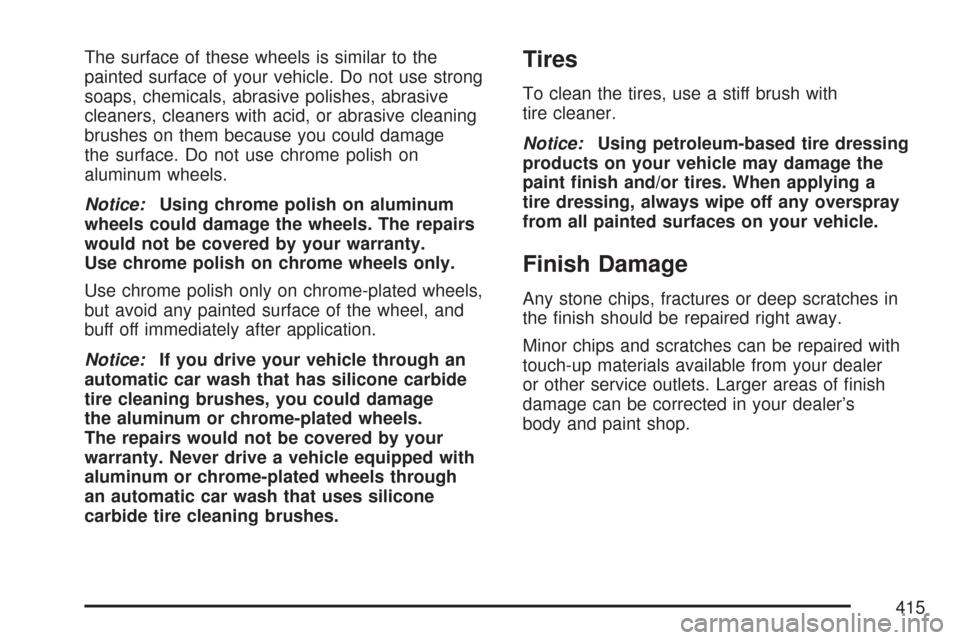
The surface of these wheels is similar to the
painted surface of your vehicle. Do not use strong
soaps, chemicals, abrasive polishes, abrasive
cleaners, cleaners with acid, or abrasive cleaning
brushes on them because you could damage
the surface. Do not use chrome polish on
aluminum wheels.
Notice:Using chrome polish on aluminum
wheels could damage the wheels. The repairs
would not be covered by your warranty.
Use chrome polish on chrome wheels only.
Use chrome polish only on chrome-plated wheels,
but avoid any painted surface of the wheel, and
buff off immediately after application.
Notice:If you drive your vehicle through an
automatic car wash that has silicone carbide
tire cleaning brushes, you could damage
the aluminum or chrome-plated wheels.
The repairs would not be covered by your
warranty. Never drive a vehicle equipped with
aluminum or chrome-plated wheels through
an automatic car wash that uses silicone
carbide tire cleaning brushes.Tires
To clean the tires, use a stiff brush with
tire cleaner.
Notice:Using petroleum-based tire dressing
products on your vehicle may damage the
paint �nish and/or tires. When applying a
tire dressing, always wipe off any overspray
from all painted surfaces on your vehicle.
Finish Damage
Any stone chips, fractures or deep scratches in
the �nish should be repaired right away.
Minor chips and scratches can be repaired with
touch-up materials available from your dealer
or other service outlets. Larger areas of �nish
damage can be corrected in your dealer’s
body and paint shop.
415